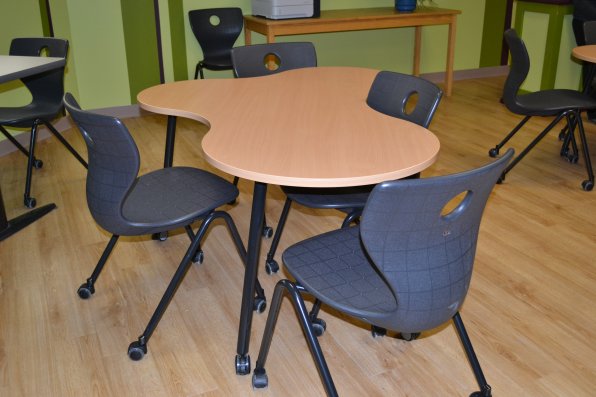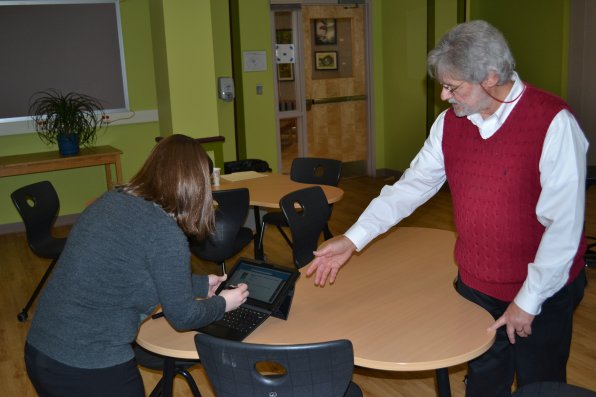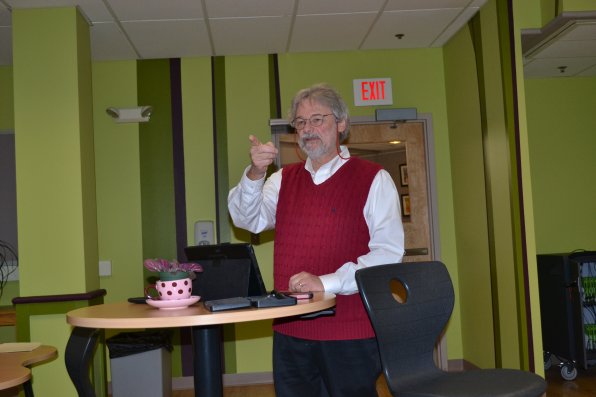Two shades of green cover the walls of the NHTI Instructional Lab. The lighter color is more dominant, taking up most of the space, while the darker one is striped in varying widths from floor to ceiling.
There are vertical purple lines as well, strategically placed around the room so if you look close enough, the three colors pair together to resemble trees.
None of the lines are straight, and that’s by design. The goal was to brighten up the renovated lab in the community college’s library, which has no windows to the outside, and make it more learning friendly.
“We really wanted to bring the outdoors indoors,” said Steve Ambra, NHTI’s director of learning resources. “In nature you don’t find right angles and the colors work with different learning styles.”
So using biophilic principles, the idea was to bring nature to the walls – and it’s also brought more students to the space. The carefully crafted lines were utilized to create a space that had no true focal point.
“It’s all about eye movement,” said Ambra.
But the colors on the walls are not the only thing that changed in the lab. It got a complete makeover. It went from space with fixed desks, older fabric chairs and desktop computers that was boring and dated to an environment that’s vibrant and comfortable – a top priority when the room was designed, along with making it one of a kind.
“There was no flexibility with the old lab,” said Sarah Hébert, head of reference services at NHTI. “It made it very difficult for students to move around.”
Instead of computers, the students have new Microsoft Office Surface tablets at their disposal, making it a more interactive learning experience.
“We did a lot of research,” said Hébert about the decision to go with tablets instead of laptops. “The battery life is incredible. We can have up to six classes in a day and not have to charge them.”
In addition to a fresh paint job, the new flooring resembles that of real wood and the tables will put you in a puzzle making mood. The chairs may look like your typical hard plastic school chairs, but they’re quite comfortable and built to last. They can also withstand an occasional spill from an iced coffee or piece of chocolate cake.
“We sat on a lot of chairs,” said Ambra.
When the students walk in for a class there is no rush to get the best seat. With all the tables and chairs on wheels, the setup possibilities for the classroom are just about endless. And Hébert has seen just about every combination since the lab was unveiled in the fall. She actually bets against herself before each class to see if she can guess what the students will design.
“The students refer to them as puzzle tables and they like to make different shapes,” said Ambra.
But that’s the point of the new classroom. To help the students feel comfortable and enhance the learning experience. They want the students to move around and feel inspired. And since there is no true focal point of the room, it’s quite easy.
“You no longer need to be locked down at a specific desk,” said Ambra. “This is an environment people really want to be in.”
Again, that’s by design. With the use of the tablets, it’s quite easy for not only the students to move around, but also Hébert. She can instruct from the teaching podium, at a table with students or standing at the Eno Board. All the tablets are synced together, allowing for a more collaborative learning experience. The Eno doubles as a dry erase board that can save up to 99 different screens for future reference. Get it? Because it’s in a library?
“We can teach from just about anywhere in the room,” said Hébert. “When the students come in they arrange the room to the learning experience they want to have.”
The goal was to create something on the cutting edge. Not just with the colors, tables and chairs, but also on the technology side. They didn’t want to just update it. They wanted to make it something people would model future classrooms off of.
“When we started this project, people thought we were crazy,” said Hébert. “Now the word is starting to spread.”
There wasn’t a lot of time to get it done. With classes running until late spring, the turnaround had to be quick. While the idea began to take shape late last school year with color designs chosen by visual arts instructor Meghan Ambra (Ambra’s daughter) and researching the right kind of technology to use, the actual construction didn’t begin until the third week of June. By the middle of August, it was ready to unveil to the college community.
“The students are taking to this room more than we could have imagined,” said Hébert.
On average, the lab sees about 3,000 students per year for instruction. But with the redesign, the number of students using it outside of classes has begun to soar. That’s what they wanted to see. The reason behind the radical change was to give NHTI students a place they want to learn.
“We realized we had an incredible opportunity to create this experience,” said Ambra.
And with some buzz in the library community, there might just be a few more of these labs popping up around the country. But right now, NHTI is happy to be the leader of the bright color lab revolution.











